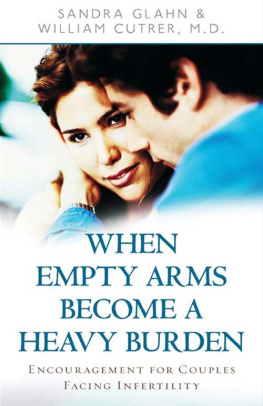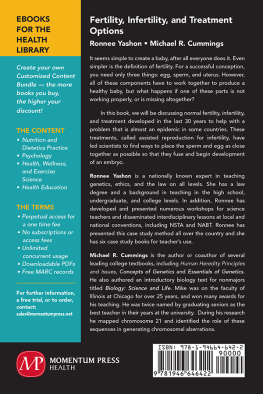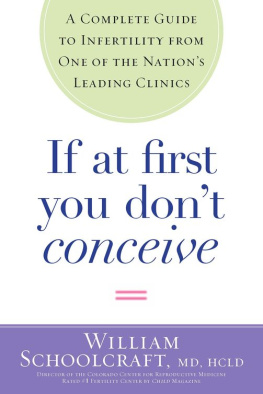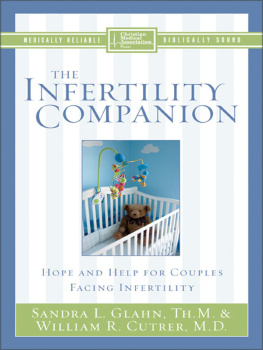Recent Titles in Health and Medical Issues Today
Alcohol
Peter L. Myers and Richard E. Isralowitz
Geriatrics
Carol Leth Stone
Plastic Surgery
Lana Thompson
Birth Control
Aharon W. Zorea
Bullying
Sally Kuykendall, PhD
Steroids
Aharon W. Zorea
Suicide and Mental Health
Rudy Nydegger
Cutting and Self-Harm
Chris Simpson
Discrimination against the Mentally Ill
Monica A. Joseph
Concussions
William Paul Meehan III
Drug Resistance
Sarah E. Boslaugh
Work-Life Balance
Janice Arenofsky
The Body Size and Health Debate
Christine L. B. Selby
Obesity: Second Edition
Evelyn B. Kelly
Infertility
Treatments
Janice Arenofsky
Health and Medical Issues Today

Copyright 2018 by ABC-CLIO, LLC
All rights reserved. No part of this publication may be reproduced, stored in a retrieval system, or transmitted, in any form or by any means, electronic, mechanical, photocopying, recording, or otherwise, except for the inclusion of brief quotations in a review, without prior permission in writing from the publisher.
Library of Congress Cataloging-in-Publication Data
Names: Arenofsky, Janice, author.
Title: Infertility treatments / Janice Arenofsky.
Description: Santa Barbara, California : Greenwood, [2018] | Series: Health and medical issues today | Includes bibliographical references and index.
Identifiers: LCCN 2018008270 (print) | LCCN 2018010806 (ebook) | ISBN 9781440858864 (ebook) | ISBN 9781440858857 (hard copy : alk. paper)
Subjects: | MESH: Reproductive Techniques, Assisted | Infertilitytherapy
Classification: LCC RC889 (ebook) | LCC RC889 (print) | NLM WQ 208 | DDC 616.6/9206dc23
LC record available at https://lccn.loc.gov/2018008270
ISBN: 9781440858857 (print)
9781440858864 (ebook)
22 21 20 19 181 2 3 4 5
This book is also available as an eBook.
Greenwood
An Imprint of ABC-CLIO, LLC
ABC-CLIO, LLC
130 Cremona Drive, P.O. Box 1911
Santa Barbara, California 93116-1911
www.abc-clio.com
This book is printed on acid-free paper 
Manufactured in the United States of America
To all the faceless individuals and couples struggling with infertility: May you reach your desired destinations trusting science and technology to take you on new pathways.
To my sisters-to-come in the year 2070: Many small steps for womens reproduction, a giant leap for mankind.
CONTENTS
SERIES FOREWORD
Every day, the public is bombarded with information on developments in medicine and health care. Whether it is on the latest techniques in treatment or research, or on concerns over public health threats, this information directly affects the lives of people more than almost any other issue. Although there are many sources for understanding these topicsfrom Web sites and blogs to newspapers and magazinesstudents and ordinary citizens often need one resource that makes sense of the complex health and medical issues affecting their daily lives.
The Health and Medical Issues Today series provides just such a one-stop resource for obtaining a solid overview of the most controversial areas of health care in the twenty-first century. Each volume addresses one topic and provides a balanced summary of what is known. These volumes provide an excellent first step for students and lay people interested in understanding how health care works in our society today.
Each volume is broken into several parts to provide readers and researchers with easy access to the information they need:
- provides overview chapters on background information including chapters on such areas as the historical, scientific, medical, social, and legal issues involvedthat a citizen needs to intelligently understand the topic.
- provides capsule examinations of the most heated contemporary issues and debates, and analyzes in a balanced manner the viewpoints held by various advocates in the debates.
- provides case studies that show examples of the concepts discussed in the previous parts.
A selection of reference material, such as a timeline of important events and a directory of organizations, serves as the best next step in learning about the topic at hand.
The Health and Medical Issues Today series strives to provide readers with all the information needed to begin making sense of some of the most important debates going on in the world today. The series includes volumes on such topics as stem-cell research, obesity, gene therapy, alternative medicine, organ transplantation, mental health, and more.
PREFACE
Although there are worse infirmities than infertility, to those receiving that diagnosis, it is a humbling, distressing experience that can wreck marriages and careers, send self-esteem plummeting, and topple plans for family building. In denial, many people spend years trying to conceive naturally although the medical definition of infertility is only one year of intercourse without attaining a pregnancy. On the other hand, some people go to the other extremethey panic after six months of negative pregnancy tests and rush to the fertility doctor for answers and assistance.
Sometimes those answers and medical protocols are clear and can be remedied through hormones, surgery, or even weight loss, but other times the reason for infertility is never completely understoodeither through clinical tests or through medical history. An unknown cause is a fierce enemy to infertile people. It discombobulates them because they worry that this embarrassing turn of events forever dooms them to the unhappy, stigmatized state of childlessness.
Yet science has kept pace with infertility problems. In the past few decades since the famous 1978 test-tube birth of Louise Brown in England, biological innovations have rescued many people from the prognosis of sterility. No longer does infertility limit couples to adoption or the childless option; instead, infertility has become a genetic adventure and a booming industry complete with donor sperm and oocytes, surrogate mothers, and high-tech procedures going by initialisms like ICSI, AI, GIFT, ZIFT, IUD, and IVF. Medical techniques and genome mapping have joined forces to dispense hope to many people whose biological clocks have essentially stopped or failed to function; the LBGT population with their missing gametes; those struggling with infectious diseases like hepatitis B and C, HIV, and Zika; and savior siblings created from a combination of IVF (in vitro fertilization) and PGD (preimplantation genetic diagnosis).
Medical harvesting of sperm and eggs can now return the reproductive function to people made infertile by cancer chemotherapy and those whose spouses or partners have died before family planning had been completed. And because the United States has imposed few regulations on the lucrative fertility industry, physicians compete and can command heavy fees. Their clinics post success rates of live births online at the CDC (Centers for Disease Control and Prevention) website, many of them boasting of high rates due partially to implanting multiples of twos and threes in the uteruses of their patients. For despite the documented danger of multiple births, which have been corroborated by professional societies, patients still agree to multiple implantings because they cannot afford to keep repeating expensive IVF procedures.










